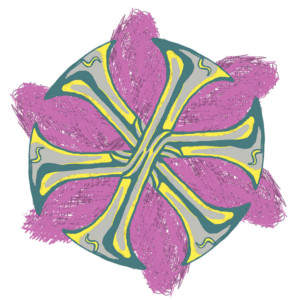
In classical trumpet playing, half-valve sounds are usually unintentional and a sign that you aren’t fully depressing the valve, or that you seriously need to oil your valves because they aren’t coming back up fast enough. This “mistake” has been taken by composers and turned into something beautiful!
Half-valve sounds are produced by depressing one or more valves partially, creating tones that sound muted, matte and do not project very well – quite distinct from a normal trumpet sound color. This technique tends to be most effective with piston valves, though it can also work with rotary (German style) valve systems.
Half-valve can be notated simply by writing ‘half-valve’ or ‘HV’ above the desired note. If the technique is used often in a piece, this may be too cumbersome, and you may want to come up with an alternative notation.

Virtually all pitches available on the trumpet (including pedal tones) can be produced using the half-valve technique. Tongue effects like flutter tongue can also be easily combined with half-valve.
With just a quick change in fingering, a player can go between a ‘normal’ sound and a half-valve sound. This allows for very rapid changes of tone color.

Copyright © 2007 by G. Ricordi & Co. Buehnen- und Musikverlag GmbH
All Rights Reserved. International Copyright Secured
Reproduced by kind permission of Hal Leonard Europe Srl obo G. Ricordi & Co. Buehnen- und Musikverlag GmbH

© Stockhausen-Stiftung für Musik, Kürten
Tones produced with half-valve are also very flexible, giving the player freedom to bend the pitch in either direction. Stay tuned for my upcoming post on that subject for more on these (and other) types of glissandi.
Half-valve technique is flexible and easy to produce, but it does have its limitations. Finding the precise valve position to produce a particular pitch can be difficult, and the pitch and sound color can be very unstable when the precise valve position is not found. For this reason fast half-valve passages that require precise pitches should generally be avoided unless you don’t mind the result being somewhat muddy and vague.
Half-Valve Split Tones
Combining split-tones with half-valve can produce a split-tone effect with intervals otherwise not possible with conventional split-tones. The result is difficult to predict or control, but does sound quite cool! My full blog post on split-tones is here.
Half-Valve Air Sounds
Check out my post on air sounds for more information about this cool effect!
Adding Mutes
While the special sound color of half-valve is definitely best enjoyed unmuted, there is a slight change in sound color when playing half-valve technique with a mute. Test some mutes with a player to find out which ones work best for your piece.
Gold Star Example

My gold star example for the use of half-valve technique goes to Chinese composer Yangfan Xu. In her piece “Qing Yi” for trumpet and choir she uses the half-valve sound of the trumpet to imitate the traditional Chinese instrument Suo Na. The half-valve passages are melodic but not too fast and the pitches are easy for the player to hear in the context of the piece.

And here is a video of the full perfomance of the piece, recorded live in 2018 at the Choral Chameleon summer institute.
